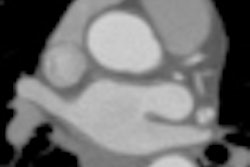
AMSTERDAM - The value of medical imaging prior to noncardiac surgery for preoperative cardiac risk assessment may have been overstated. Importantly, guidelines issued in 2009 are considered insecure and may need to be rewritten, according to a cardiac imaging expert at this week's European Society of Cardiology (ESC) meeting.
 Dr. Richard Underwood.
Dr. Richard Underwood.
"While it is a natural inclination to image patients with cardiac risk for noncardiac surgery, the evidence that we can benefit patients by doing this is less now than previously. Clinicians should be more circumspect about imaging tests to assess risk," he told AuntMinnieEurope.com in an interview at this week's ESC meeting.
"Good, old-fashioned clinical judgment seems to be the way forward," Underwood continued. "Clinical assessment still rules."
Dated guidelines?
Indeed, guidelines on the assessment of risk prior to noncardiac surgery are relatively dated and are being reconfigured due to recent developments related to academic fraud.
There are approximately 40 million noncardiac surgical procedures annually in Europe, 400,000 perioperative myocardial infarctions (1%), and 133,000 cardiovascular deaths (0.3%). Typical noncardiac surgery might include orthopedic or abdominal surgery, but the high-risk operations involve the peripheral vascular system, such as abdominal aortic aneurysm repair.
"There's a considerable risk of morbidity with noncardiac procedures, so firstly, we want to detect high-risk patients before surgery and help reduce this risk, and secondly, if risk has been detected, can we actually do anything to minimize this because an event might be inevitable and no treatment can reverse this," Underwood said.
High-risk patients are usually detected via stress functional imaging techniques; for example, nuclear cardiology or myocardial perfusion scintigraphy (MPS). Data from a meta-analysis (Journal of Nuclear Cardiology, May/June 1998, Vol. 5:3, pp. 332-342) suggest that in patients undergoing vascular surgery, those that show a normal MPS upon preoperative risk assessment have a very high negative predictive value (99%), so the vast majority of patients did not experience an event. In patients who gave an abnormal scan, 12% subsequently had an event.
In his talk, Underwood addressed the question relating to what extent MPS should be used, given that it exposes patients to radiation and is costly, at approximately 400 pounds (472 euros) per scan.
In 2009, the ESC and the American College of Cardiology (ACC) published their guidelines for preoperative cardiac risk assessment and perioperative cardiac management in noncardiac surgery. "These guidelines suggested that noninvasive testing, for example with MPS, should be used at the end and only in a minority of patients [step 7 of 7]," Underwood said. "There's only one small category of patients, so this restricted use of MPS, where it may have hitherto been used too frequently."
Doubt on DECREASE studies
But then in 2011, a family of studies known as the DECREASE (the Dutch Echographic Cardiac Risk Evaluation Applying Stress Echo) studies I - VI, which had formed the foundation of the 2009 ESC guidelines, were no longer considered reliable. The principal investigator of the studies, and chairman of the 2009 ESC guidelines, Dr. Don Poldermans, previously of the Thorax Center, Erasmus Medical Center in Rotterdam, the Netherlands, was dismissed for violations of academic integrity, including careless collection of data and fictitious data to prop up his findings.
"These 2009 guidelines are now strongly suspect, in particular the aspect that relates to whether risk of surgery is reduced by use of beta-blockade. This guideline is now considered insecure and new guidelines will be published in spring 2014," Underwood remarked.
In order to reinvestigate the value of beta-blockade as a preoperative measure to reduce risk, a paper published in the journal Heart in July 2013 provided a meta-analysis of secure, well-conducted trials that examined the use of beta-blockade to reduce risk. The researchers concluded beta-blockade, part of the bedrock evidence for the 2009 guidelines, does harm rather than good.
Prior to noncardiac surgery, 10,529 patients in nine trials were randomized to either beta-blockade or no beta-blockade, and then followed up for mortality within 30 days or at discharge. In these secure trials, the risk ratio shows the risk for patients on beta-blockade was less favorable than those not on beta-blockade. In stark contrast, the DECREASE trials showed the opposite results.
Specifically, the authors wrote that in conflict with the DECREASE trial evidence, and the 2009 guidelines, initiation of a course of beta-blockers before surgery caused a statistically significant 27% risk increase in 30-day all-cause mortality (p = 0.04). They added that in the secure trials of the meta-analysis, beta-blockade reduced nonfatal myocardial infarction (relative risk [RR] 0.73, p = 0.001), but increased stroke (RR 1.73, p = 0.05) and hypotension (RR 1.51, p < 0.00001).
Guideline bodies should "retract their recommendations based on fictitious data without further delay," the study authors noted.
"Due to the doubt about what we can do to reduce the risk of noncardiac surgery, imaging is likely to be less helpful than previously thought," Underwood concluded.



















